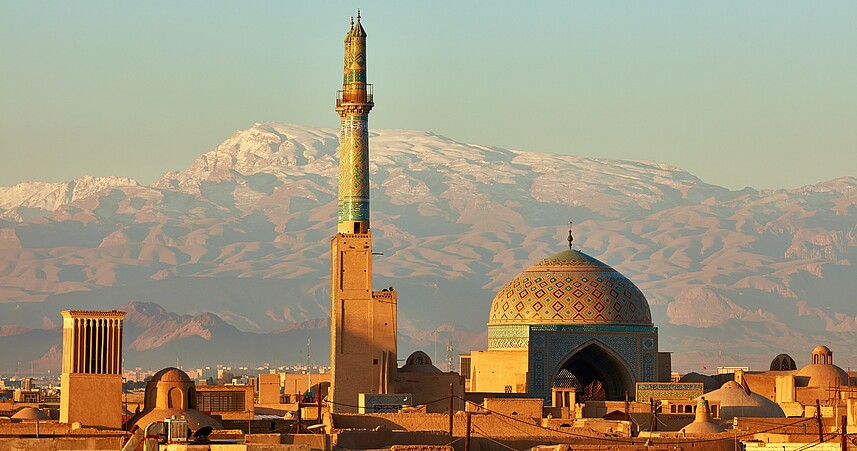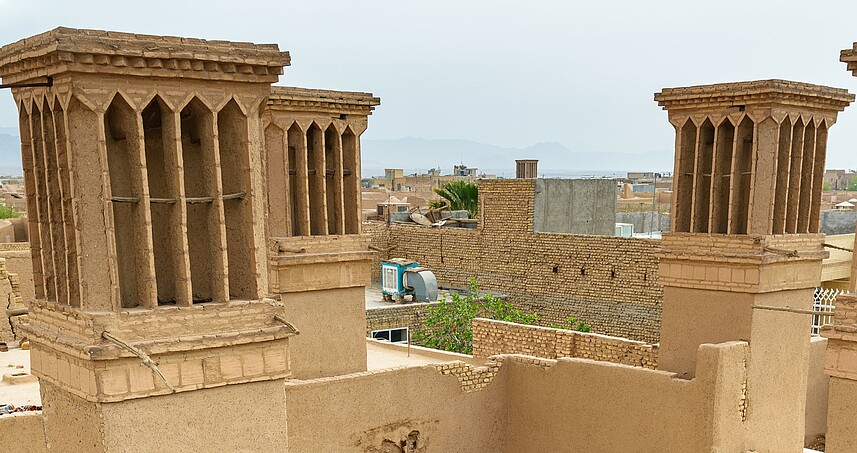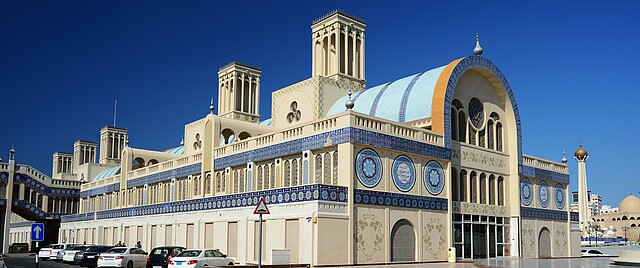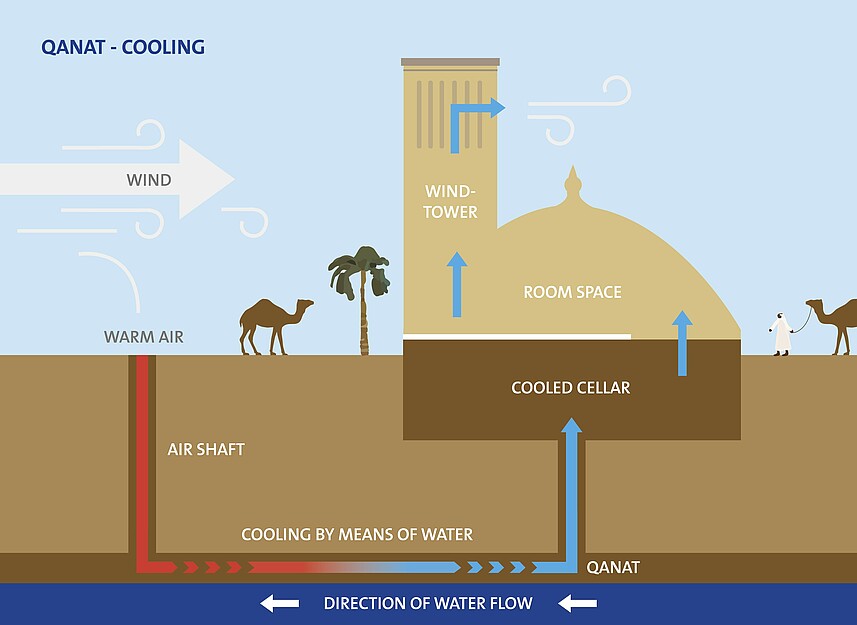Clever constructions
Centuries-old Arab architectural solution delivers clean indoor air
Home sweet home – this well-known saying conveys a sensible message. Because most of the time, our own home is where we feel most comfortable. Poor indoor air, in contrast, isn’t sweet at all: interior spaces can be full of pollutants that compromise the health of the inhabitants, in both modern and classic homes. However, no matter where they live, human beings have devised smart architectural solutions that help them breathe freely – and enjoy clean air. For centuries, the idea behind smart buildings has proven its value.
They are invisible to the naked eye: indoors, all kinds of particles and gases are whirling through the air – from toner dust to volatile organic compounds (VOCs) from varnishes and paints. Now, that might not be such a serious concern – if it weren’t for the amount of time we spend indoors. According to recent estimates, in industrialized countries it makes up 90 percent of our lifetime.
Compared to our outdoor time, this constantly living indoors comes at a fairly high price. In 2016, researchers from the British Royal College of Physicians and from the Royal College of Paediatrics and Child Health confirmed that poor indoor air could cause diseases. Gas stoves, ovens and irritant chemicals in new furniture, for instance, can make children and adults more likely do develop asthma. In particularly sensitive individuals, these vapours can even lead to heart attacks and strokes.
Air from a tower
How can these problems be prevented? Construction materials manufacturers are increasingly offering products without noxious substances. However, for the time being, entirely pure air remains virtually impossible. Fresh air, however, is a viable solution. Throughout history, mankind has come up with various ideas for securing it. Above all, one thing is essential for good indoor air: a steady exchange between stale indoor air and fresh air from outside.
In the Persian Gulf and the Mediterranean, so-called windtowers have provided this vital exchange for centuries. Located outside the house and up to 15 meters tall, they transfer cool sea air from the upper part of the tower into its shady interior. From there, the cool air flows into the interior of the house, replacing the hot air. Besides ventilation, windtowers make for pleasingly cool temperatures.
The design is the key
Unfortunately, not every house is located in the Gulf region, or even near a sea. Moreover, especially in Europe, there is a modern type of house that makes it virtually impossible to properly ventilate. Low-energy or passive homes feature sealed outer walls that air can’t penetrate.
This helps to save energy, but the insulation also has its drawbacks: the air hardly circulates, while the sealed-off indoor spaces offer an ideal breeding ground for mold spores. Further, the vapors produced by various appliances remain trapped inside the buildings. Instead of windtowers, industrialized countries tend to rely on ventilation systems and air purifiers in various shapes and sizes.

Mobile is trending
Especially in China, a country plagued by serious air pollution, mobile indoor air purifiers are booming. Instead of bulky appliances, they are small and decorative. Resembling vases, drinking glasses or loudspeakers, these “air optimizers” can even be remotely controlled using specialized apps, delivering smart living at its best.
These mobile devices are quickly gaining in popularity, even in large industrialized countries like the US and Canada. They clean the air while homeowners are at work or out taking care of the grocery shopping. Although this type of air cleaner is currently most often found in the Far East, it is increasingly penetrating the European market. Online shoppers who actively look for these devices will find a wealth of designs and broad price range.
A chimney for clean air
But there are not only purifiers inside of buildings; there are also entire buildings that serve as purifiers. Just like the mobile gadgets, China is the birthplace of this development. In early 2018, the Chinese city of Xi’an made headlines thanks to an ambitious construction project. Researchers from the Chinese Academy of Sciences were building a 100-meter-high tower. Reminiscent of Arab windtowers, it resembles a giant chimney, but features an array of filters inside.
Here is how the unconventional design works: inside the chimney, warm air rises, creating a vacuum that sucks in additional air from the outside. This air passes through the filters, which remove any particulate matter, so that nothing but clean air is left – and loads of it. According to the Chinese Academy of Sciences, the specialized chimney provides more than ten million cubic meters of clean air per day, which benefits everyone living in the surrounding ten square kilometers.

The art of efficient filtering
But no matter how large the filter, ridding the air of particles and gases is an art in itself. There are countless approaches, from chemical to natural and water-based air cleaning. So-called air washers suck in indoor air and feature an integrated water bath that retains coarse particles. In this way, they both clean and humidify the air. Ionizers, in turn, emit negatively charged ions; though this method effectively binds household dust, it also produces environmentally harmful ozone.
However, there are also air purifiers that comprise several layers of filters, and can successfully remove unwanted particles or gases without either water or ozone. Energy-efficient filters from Freudenberg Filtration Technologies can prevent particulate matter from contaminating indoor air. Our filter solutions ensure that the air in your home or at the workplace stays clean, contributing to a better living experience.
Sources
https://www.wired.de/collection/tech/china-hat-den-groessten-luftfilter-der-welt-gebaut
https://www.freudenberg-filter.com/de/world-of-living/bueroausstattung/
http://www.chip.de/artikel/Luftreiniger-gegen-Allergien-Klimageraete-machen-Pollen-den-Garaus_138376578.html
http://www.faz.net/aktuell/gesellschaft/gesundheit/luftfilter-in-der-wohnung-werden-immer-beliebter-15076039.html
https://www.golem.de/news/umwelt-china-baut-100-meter-turm-fuer-die-luftreinigung-1801-132303.html
https://www.haustechnikdialog.de/SHKwissen/2170/Windturm
https://www.stern.de/panorama/wissen/mensch/feinstaub--luftfilter-sinnvoll-zum-reinigen-der-luft-in-der-wohnung--6658614.html
https://www.rcplondon.ac.uk/projects/outputs/every-breath-we-take-lifelong-impact-air-pollution












